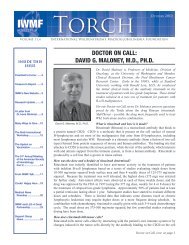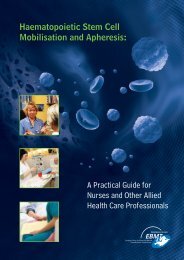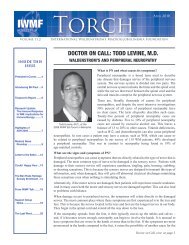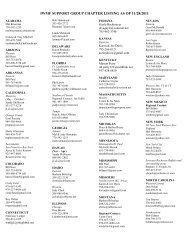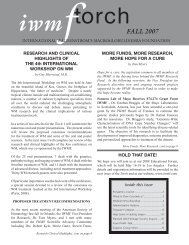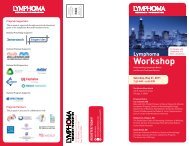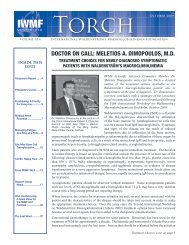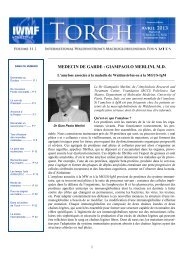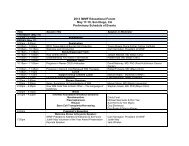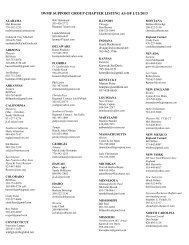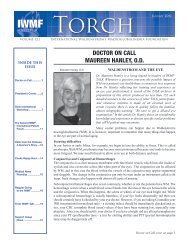English - International Waldenstrom's Macroglobulinemia Foundation
English - International Waldenstrom's Macroglobulinemia Foundation
English - International Waldenstrom's Macroglobulinemia Foundation
You also want an ePaper? Increase the reach of your titles
YUMPU automatically turns print PDFs into web optimized ePapers that Google loves.
Support Group News, cont. from page 24<br />
many of whom are on watch-and-wait following previous<br />
treatments and anticipate needing treatment again at some<br />
point in the future. The meeting also featured round table<br />
introductions and status updates as well as warm welcomes to<br />
new members. Claire Kammen of the Indiana LLS provided<br />
breakfast snacks and lots of good coffee. As usual, there was<br />
candy on the table for all to enjoy. The group thanks the LLS<br />
for its ongoing support. The meeting schedule includes three<br />
meetings per year, usually spring, summer, and fall, on a<br />
Saturday morning from 10 am to noon.<br />
NEW ENGLAND<br />
Boston<br />
Early in 2013, the New England WM support group got<br />
together twice. The group met on a cold but sunny Sunday<br />
in January at the Dana-Farber Cancer Institute. The support<br />
group leaders, Judy Christensen and Lynn and Joe Mara,<br />
led a round table discussion during which WMers and<br />
caregivers shared experiences and sought information from<br />
others present. Members were inspired to learn that two<br />
“long-timers” had their diagnoses 17 and 14 years ago.<br />
Another WMer has been on watch-and-wait since diagnosis<br />
eight years ago. Others shared their experiences with clinical<br />
trials; while for some the trials went well, for others there<br />
were some side effects. In March a great crowd came out<br />
to hear Dr. Steven Treon of Dana-Farber give his annual<br />
“State of the WM World.” Dr. Treon discussed the latest<br />
advances in research and the newest drugs being evaluated.<br />
Of great interest for the WM community was the growing<br />
understanding of the role of the L265P mutation in the gene<br />
for MYD88. This mutation was discovered through the<br />
efforts of Dr. Treon and his group at DFCI and was partially<br />
funded by the IWMF.<br />
NEW YORK<br />
New York City<br />
The extremely well-informed, articulate participants in the<br />
New York metro-area group refused to let a cold January<br />
day discourage their meeting. They have succeeded so<br />
well in educating themselves that sitting in on a gathering<br />
can feel a bit like attending an abbreviated version of the<br />
IWMF Educational Forum. Several newly diagnosed WMers<br />
joined the throng, arriving with many questions, including<br />
where to find the experienced doctors and what treatments<br />
are working best. It is fair to say that they left calmer, more<br />
knowledgeable, and, most importantly, more hopeful about<br />
their futures. The members look forward to these new patients<br />
becoming regular members who will continue to share their<br />
Waldenstrom journeys. The group would love to welcome<br />
any WMer visiting NYC on a Sunday meeting day to join in<br />
a high-energy, upbeat experience.<br />
OREGON/SOUTHWEST WASHINGTON<br />
The support group met on a rainy, cool, winter day in January,<br />
but the warmth and collegiality of the group inside made up<br />
for the gray skies outside. Twenty-seven members gathered<br />
to greet each other, share lunch, and hear a presentation by<br />
Dr. Stephen Spurgeon, an oncologist and researcher at the<br />
Knight Cancer Institute of the Oregon Health and Sciences<br />
University. His talk, “News You Can Use: An Update on<br />
Waldenstrom’s from the Latest ASH Conference,” included a<br />
review of WM basics, detailed some of the latest drugs being<br />
used for treatment, and presented the positive and negative<br />
aspects of each of the options available at present. He<br />
conveyed a hopeful message as he discussed the continuing<br />
advances made in understanding lymphoid cancers in<br />
general and in WM specifically. Of particular interest was<br />
the impact of the MYD88 L265P mutation on the pathways<br />
of a WM cell. Identification of the mutation by Dr. Treon’s<br />
group at Dana-Farber was made possible by whole genome<br />
sequencing. The implication for treatments is centered on<br />
finding effective ways to disrupt the impact of the mutation<br />
in order to cause the death of the WM cell. Dr. Spurgeon<br />
communicated the highly technical information in a way that<br />
the group was able to understand. The questions were many<br />
and the discussion was lively. Members felt encouraged and<br />
hopeful for the future. The next meeting is planned for April<br />
28 at the Fairfield Inn and Suites, 6100 Meadows Road, Lake<br />
Oswego, OR. The local chapter of the LLS partners with<br />
the IWMF chapter to host the meetings. The LLS secures<br />
the meeting place, helps to coordinate speakers, aids with<br />
publicity, and provides lunch for the group.<br />
PENNSYLVANIA<br />
Harrisburg Area<br />
The group members met early in February to discuss articles<br />
from the IWMF Torch newsletter. They also exchanged<br />
information on their current status and treatments and<br />
brought each other up to date on absent members. Don and<br />
Kate Wolgemuth provided light snacks to fuel the energetic<br />
sharing among special friends. And Terrie Eshleman brought<br />
Russell Stover Private Reserve Sugar Free Chocolates. They<br />
are 60% cacao and have raspberry or vanilla caramel filling<br />
(a great discovery!). Plans are afoot to meet again on the third<br />
Sunday in May, again at the Messiah Village at 2 pm.<br />
Philadelphia<br />
Seventeen people and one dog met at group leader Karen<br />
Pindzola’s house in early December. The topic, “how to<br />
keep from getting sick” came up, probably because flu<br />
season was beginning and WMers are always a little cautious<br />
about catching something. Everyone had a suggestion. Wash<br />
hands often. Use hand sanitizer if you can’t wash. Avoid<br />
sick people. Use a face mask, particularly when using public<br />
transportation, trains, and planes. Watch out in the doctor’s<br />
office—all those magazines, doorknobs, and most anything<br />
else in the waiting room. Don’t be too tempted to hug your<br />
runny-nosed grandkids; wait until spring. Don’t touch your<br />
face. Take a multivitamin every day. And on it went. In sum,<br />
WMers need to be aware of these things and do what they<br />
can, while continuing to enjoy a full life. At the March gettogether,<br />
the group discussed the IWMF Patient Database and<br />
what it can do for patients. Enthusiasm fuels each gathering<br />
and after every one there is time for chatting and enjoying the<br />
goodies participants have brought along.<br />
IWMF TORCH Volume 14.2<br />
25



